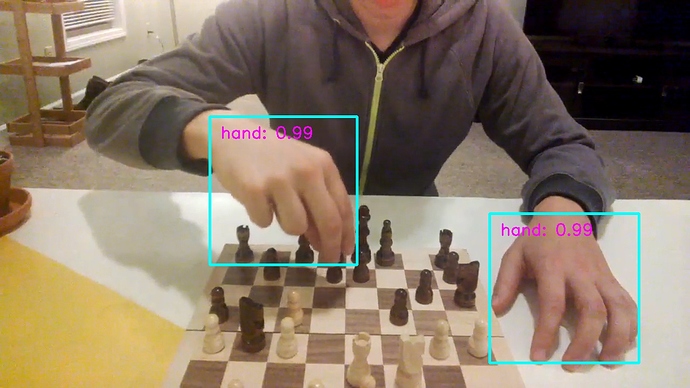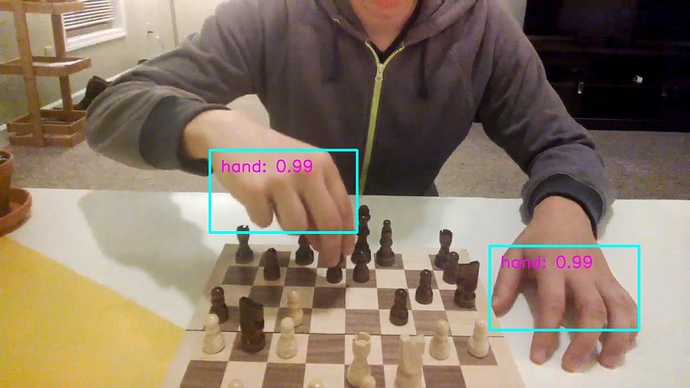When using relay frontend to read a SSD model (.onnx) .
The model is mobilenetv2-SSD based model trained with hand dataset.
The right result by Pytorch is:
But with TVM. Althougn it can produce reasonable result, the result seems strange:
Because the model head layer does’t contain nms layer, both final results are produced with nms function which is apart with model.
When I track the data between the two ways, the scores data seem right but the boxes data is a little different.
Has anyone had the same problem ?
Any help? Thanks~ I’m so confused 
The code is:
import onnx
import cv2
import tvm
import numpy as np
import tvm.relay as relay
from tvm.contrib import graph_runtime
from PIL import Image
def area_of(left_top, right_bottom):
"""Compute the areas of rectangles given two corners.
Args:
left_top (N, 2): left top corner.
right_bottom (N, 2): right bottom corner.
Returns:
area (N): return the area.
"""
hw = np.clip(right_bottom - left_top, a_min=0.0, a_max=None)
return hw[..., 0] * hw[..., 1]
def iou_of(boxes0, boxes1, eps=1e-5):
"""Return intersection-over-union (Jaccard index) of boxes.
Args:
boxes0 (N, 4): ground truth boxes.
boxes1 (N or 1, 4): predicted boxes.
eps: a small number to avoid 0 as denominator.
Returns:
iou (N): IoU values.
"""
overlap_left_top = np.maximum(boxes0[..., :2], boxes1[..., :2])
overlap_right_bottom = np.minimum(boxes0[..., 2:], boxes1[..., 2:])
overlap_area = area_of(overlap_left_top, overlap_right_bottom)
area0 = area_of(boxes0[..., :2], boxes0[..., 2:])
area1 = area_of(boxes1[..., :2], boxes1[..., 2:])
return overlap_area / (area0 + area1 - overlap_area + eps)
def hard_nms(box_scores, iou_threshold, top_k=-1, candidate_size=200):
scores = box_scores[:, -1]
boxes = box_scores[:, :-1]
picked = []
indexes = np.argsort(-scores)
indexes = indexes[:candidate_size]
while len(indexes) > 0:
current = indexes[0]
picked.append(current.item())
if 0 < top_k == len(picked) or len(indexes) == 1:
break
current_box = boxes[current, :]
indexes = indexes[1:]
rest_boxes = boxes[indexes, :]
iou = iou_of(
rest_boxes,
current_box[np.newaxis, :]
)
indexes = indexes[iou <= iou_threshold]
return box_scores[picked, :]
label_path = 'hand-model-labels.txt'
onnx_model = onnx.load('MobileNetV2-SSDLite-Hand.onnx')
orig_image = cv2.imread('../../datasets/hand-image/hands.jpg')
width = orig_image.shape[1]
height = orig_image.shape[0]
class_names = [name.strip() for name in open(label_path).readlines()]
img = Image.open('../../datasets/hand-image/hands.jpg').resize((300, 300))
img = np.array(img).transpose((2, 0, 1)).astype('float32')
img = img[np.newaxis, :]
img = img/255.0 # remember pytorch tensor is 0-1
x = img
target = 'llvm'
input_name = '0'
shape_dict = {input_name: x.shape}
sym, params = relay.frontend.from_onnx(onnx_model, shape_dict)
with relay.build_config(opt_level=3):
graph, lib, params = relay.build_module.build(sym, target, params=params)
print("Reading model files...")
libpath = "MobileNetV2-SSDLite.so"
lib.export_library(libpath)
graph_json_path = "MobileNetV2-SSDLite.json"
with open(graph_json_path, 'w') as fo:
fo.write(graph)
param_path = "MobileNetV2-SSDLite.params"
with open(param_path, 'wb') as fo:
fo.write(relay.save_param_dict(params))
dtype = 'float32'
loaded_json = open(graph_json_path).read()
loaded_lib = tvm.module.load(libpath)
loaded_params = bytearray(open(param_path, "rb").read())
ctx = tvm.cpu()
m = graph_runtime.create(loaded_json, loaded_lib, ctx)
m.set_input('0', tvm.nd.array(x.astype(dtype)))
m.load_params(loaded_params)
m.run()
scores = m.get_output(0).asnumpy()
boxes = m.get_output(1).asnumpy()
boxes = boxes[0]
scores = scores[0]
prob_threshold = 0.4
picked_box_probs = []
picked_labels = []
for class_index in range(1, scores.shape[1]):
probs = scores[:, class_index]
mask = probs > prob_threshold
probs = probs[mask]
if probs.shape[0] == 0:
continue
subset_boxes = boxes[mask, :]
box_probs = np.concatenate((subset_boxes, probs.reshape(-1, 1)), axis=1)
box_probs = hard_nms(box_probs, prob_threshold, top_k=10, candidate_size=200)
picked_box_probs.append(box_probs)
picked_labels.extend([class_index] * box_probs.shape[0])
picked_box_probs = np.concatenate(picked_box_probs)
picked_box_probs[:, 0] *= width
picked_box_probs[:, 1] *= height
picked_box_probs[:, 2] *= width
picked_box_probs[:, 3] *= height
boxes, labels, probs = picked_box_probs[:, :4], np.array(picked_labels), picked_box_probs[:, 4]
for i in range(boxes.shape[0]):
box = boxes[i, :]
cv2.rectangle(orig_image, (box[0], box[1]), (box[2], box[3]), (255, 255, 0), 4)
label = f"{class_names[labels[i]]}: {probs[i]:.2f}"
cv2.putText(orig_image, label,
(int(box[0]) + 20, int(box[1]) + 40),
cv2.FONT_HERSHEY_SIMPLEX,
1, # font scale
(255, 0, 255),
2) # line type
path = "run_ssd_example_output.jpg"
cv2.imwrite(path, orig_image)
print(f"Found {len(probs)} objects. The output image is {path}")


